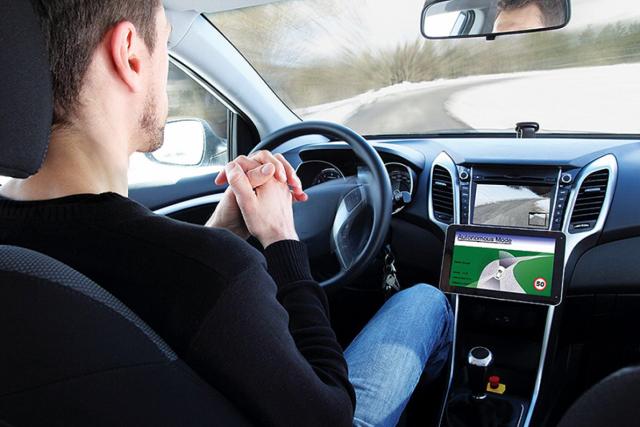Warning: Automated Cars And Their Operators Fail To Detect Dangers

HOUSTON, TX… – Automated cars are becoming more
common, but they still require drivers to react to dangers that aren’t detected
by an automated system. New research from Rice University and Texas Tech
University has found that drivers often fail to spot hazards missed by
automated vehicles, and it only gets worse the longer drivers ride in them.
The study, “DriverVigilance in Automated Vehicles: Effects of Demands on Hazard DetectionPerformance,” will appear in an upcoming edition of
Human Factors.
The researchers examined the behavior of 60
licensed drivers operating an automated car in a simulator. Participants were
told that due to the automation, they would not need to operate the steering
wheel, brake pedal or accelerator pedal. They were instructed to monitor the
roadway for vehicles that were stopped dangerously at intersections and
intruding into the driver’s lane, which constituted a hazard that automated
vehicles could not detect. Participants also had to distinguish between
vehicles that were safely stopped and dangerously stopped at intersections.
The drivers' accuracy dropped between 7 and 21 percent over the 40-minute
simulation. Even in the first 10 minutes the success rate was, at best, close
to 88 percent, suggesting that all drivers missed at least some hazards.
So why did this happen?
Pat DeLucia, a professor of psychological sciences
at Rice and the study’s co-author, said that one possibility is that people get
used to cars doing the driving and become complacent. Coupled with previous
research that indicated people are terrible at monitoring for hazards that only
happen every once in a while, and that over time their ability to respond decreases,
the new study “suggests that this phenomenon of difficulty monitoring
effectively over time extends to monitoring an automated car,” DeLucia
said.
“The bottom line
is, until automated driving systems are completely reliable and can respond in
all situations, the driver must stay alert and be prepared to take over,” said
Eric Greenlee, an assistant professor of psychological sciences at Texas Tech
and the study's lead author. “And this research clearly shows that is not
happening, and gets worse as time passes.”
The researchers hope this work will add to the
growing body of research about the safety of automated cars.
“These vehicles
have a lot to offer, but we’re a long way from being able to detect everything
going on,” the researchers wrote. “Until that day comes, we hope this research
will raise awareness about the limitations of automated cars and their
operators.”
The study was co-authored by David Newton, a graduate student at Texas Tech.
<!-- /* Font Definitions */ @font-face {font-family:"Cambria Math"; panose-1:2 4 5 3 5 4 6 3 2 4; mso-font-charset:0; mso-generic-font-family:roman; mso-font-pitch:variable; mso-font-signature:-536870145 1107305727 0 0 415 0;} @font-face {font-family:Calibri; panose-1:2 15 5 2 2 2 4 3 2 4; mso-font-charset:0; mso-generic-font-family:swiss; mso-font-pitch:variable; mso-font-signature:-536859905 -1073732485 9 0 511 0;} @font-face {font-family:"ITC Clearface Black"; panose-1:2 11 6 4 2 2 2 2 2 4; mso-font-alt:Calibri; mso-font-charset:0; mso-generic-font-family:auto; mso-font-format:other; mso-font-pitch:variable; mso-font-signature:3 0 0 0 1 0;} @font-face {font-family:"ITC Clearface"; panose-1:2 11 6 4 2 2 2 2 2 4; mso-font-alt:Calibri; mso-font-charset:0; mso-generic-font-family:auto; mso-font-format:other; mso-font-pitch:variable; mso-font-signature:3 0 0 0 1 0;} /* Style Definitions */ p.MsoNormal, li.MsoNormal, div.MsoNormal {mso-style-unhide:no; mso-style-qformat:yes; mso-style-parent:""; margin:0in; margin-bottom:.0001pt; mso-pagination:widow-orphan; font-size:12.0pt; font-family:"Calibri",sans-serif; mso-ascii-font-family:Calibri; mso-ascii-theme-font:minor-latin; mso-fareast-font-family:Calibri; mso-fareast-theme-font:minor-latin; mso-hansi-font-family:Calibri; mso-hansi-theme-font:minor-latin; mso-bidi-font-family:"Times New Roman"; mso-bidi-theme-font:minor-bidi;} .MsoChpDefault {mso-style-type:export-only; mso-default-props:yes; font-family:"Calibri",sans-serif; mso-ascii-font-family:Calibri; mso-ascii-theme-font:minor-latin; mso-fareast-font-family:Calibri; mso-fareast-theme-font:minor-latin; mso-hansi-font-family:Calibri; mso-hansi-theme-font:minor-latin; mso-bidi-font-family:"Times New Roman"; mso-bidi-theme-font:minor-bidi;} @page WordSection1 {size:8.5in 11.0in; margin:1.0in 1.0in 1.0in 1.0in; mso-header-margin:.5in; mso-footer-margin:.5in; mso-paper-source:0;} div.WordSection1 {page:WordSection1;} -->